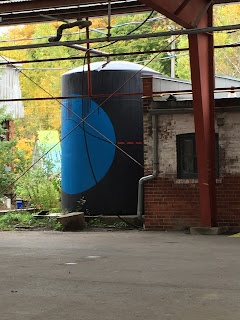Hey everyone!
Last week,
my class and I visited Evergreen Brickworks in Toronto, Ontario. Evergreen
Brickworks is an old brick making factory that has been turned into a beautiful
green space. Not only has Evergreen reused an old, historic building, but the
building also has a LEED Platinum Certification. But, what does that mean? What
is LEED? LEED stands for Leadership in Energy and Environmental Design and is a
"rating system that is recognized as the international mark of excellence
for green building in 150 countries." Received from http://www.cagbc.org/CAGBC/LEED/CAGBC/Programs/LEED/Going_green_with_LEE.aspx?hkey=54c44792-442b-450a-a286-4aa710bf5c64
In simpler terms, LEED is an organization recognized to
certify buildings that must have met
certain criteria. To become LEED certified, a building is reviewed under several ‘credit categories.’
These include: location/transportation, water efficiency, energy and
atmosphere, materials and resources, indoor environmental quality, innovation
and regional priority. Each of these categories is divided up into several
design requirements. If these requirements are reached, then the building gets
a certain number of ‘points’ on a ‘checklist’. Depending on the number of
points the building achieves, then they may get a certain certificate saying
they are LEED certified. The four certifications a building may receive are
‘LEED certified’, LEED Silver, LEED Gold or LEED Platinum.
(Different building types have their own
set of LEED rating guidelines and checklists under the new LEED v4, including
‘Building Design and Construction’ (BD and C), ‘Interior Design and
Construction’ (ID and C), ‘Building Operations and Maintenance’ (O and M),
‘Neighborhood Development’ (ND), and ‘Homes and Midrise’.)
Therefore, Evergreen Brickworks has the highest LEED Certification
available.
The History of Evergreen Brickworks - https://www.evergreen.ca/
In 1889, William Taylor and his two brothers opened "Don Valley
Brick Works" and in 1901 they sold the factory to their brother-in-law
Robert Davies. In 1904, "The Great Fire" destroyed most of the
downtown core, which resulted in new by-laws requiring masonry construction for
most buildings, creating more business for the factory. In 1984 the factory closed and was left to sit there while people used
the abandoned factory as a playground for urban explorers, partiers and
photographers. That is until 1991, when Evergreen began to lead tree-planting
activities in the Lower Don Watershed and a year later in 1992, the first phase
of park development was undertaken with the support of from the City, TRCA, as
well as a significant private donation by the Weston Foundation. In 2002,
Evergreen began to explore the ideas that are now taking physical shape as this
new environmental centre. And in 2006, the first Evergreen Brick Works farmers’
market and summer programming opened for the public. Two years later, in 2008,
ground-breaking was celebrated and construction began.
Now,
Evergreen Brickworks is a thriving place for those in the Greater Toronto Area
to get away from the city and enjoy nature at its finest. It is home to the
Evergreen Garden Market, The Tiffany Commons, Sweet Pete's Bike Shop, The
Children's Garden in Chimney Court, Koerner Gardens, Weston Family Quarry
Garden & Don Valley Brick Works Park and much more.
 |
| The Tunnels where the bricks would pass through |
 |
| Art |
 |
| More art. |
 |
| The VERY LARGE Rain Barrels |
The rest of the pictures are just scenic pictures that I took






















